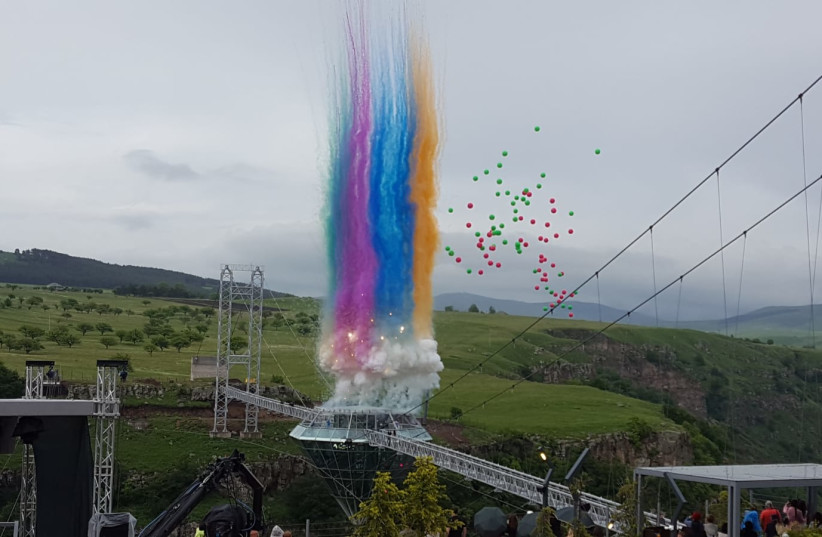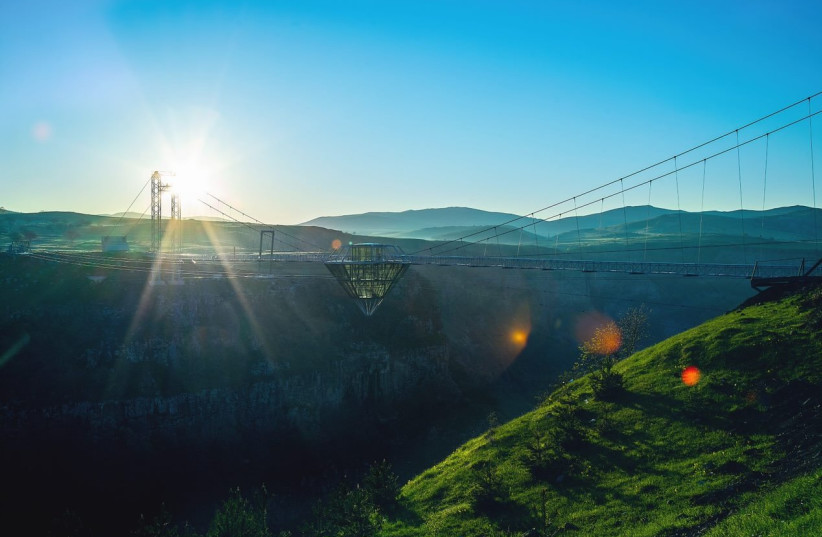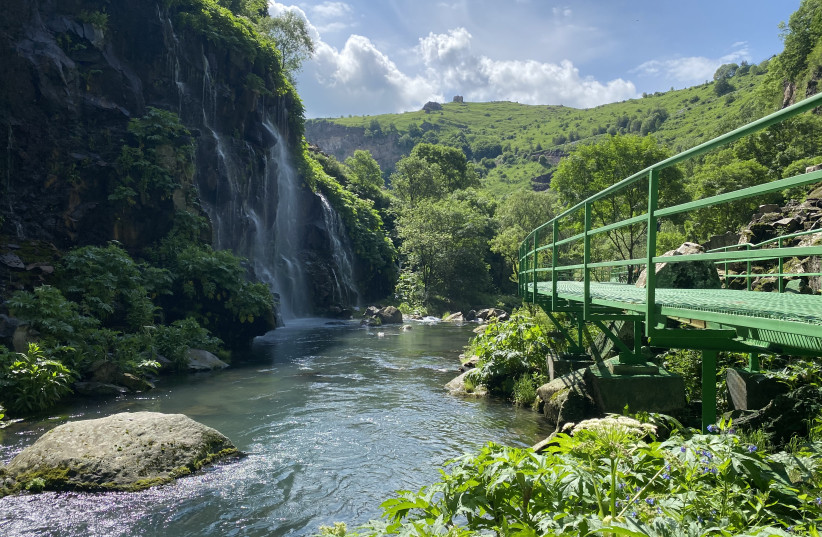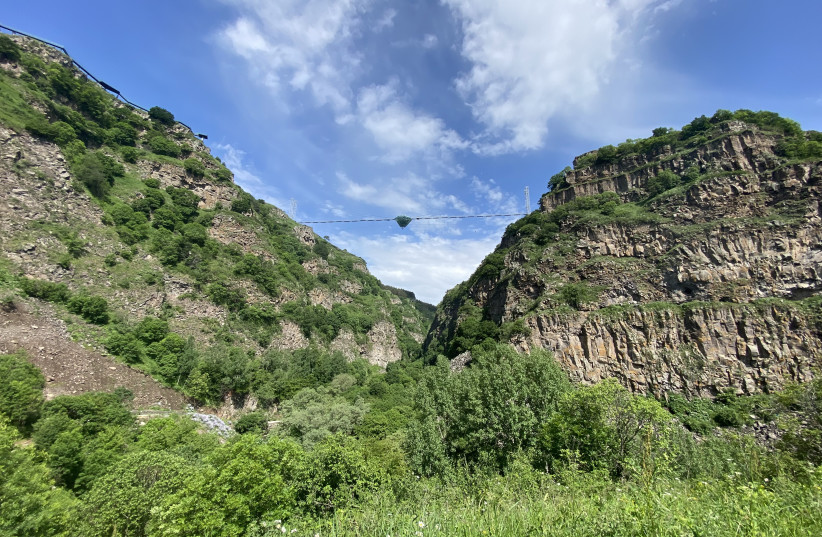TSALKA NATURE RESERVE — Set between a gorge in Georgia’s Dashbashi Canyon, Kassland’s Diamond Bridge is a wonder of architecture and vision.
The bridge, built by the Georgian-Israeli investment group Kass Group, officially opened on June 14 in the presence of Georgian Prime Minister Irakli Garibashvili.
“It’s a country with incredible views. There are not many places that can provide such beautiful landscapes; we took this reserve and we built this wonderful project.”
Pnina Revah, CEO of Kass Group Israel
Georgia's diamond
A two-hour drive from the capital of Tbilisi, the bridge set in the stunning Tsalka Nature Reserve. Though a long and winding drive, the views and the end location are more than worth it.
The Dashbashi Canyon is located at an altitude of 1100-1500 meters above sea level and is 8 kilometers in length. The canyon is made up of 669 hectares (2,000 dunams) and is full of spectacular waterfalls and caves along its luscious green slopes, seen as you walk across the glass bridge and while you sip on your coffee or champagne at the Diamond Bar.
It’s not for the faint-hearted. As you walk across the 240-meter-long glass bridge that rises 280 meters, it’s as if you are floating, with a gorge beneath your feet.

The Diamond Bar
The Diamond Bar was designed and planned by Tomer Mor Yosef, Vice President of Kass Group, and its construction took three years with the involvement of teams from the Netherlands, Belgium, and Germany who had to construct the structure from steel and glass without harming the amazing natural wonder that is the canyon.
The transparent Diamond Bar is the largest and tallest hanging structure in the world and is competing for a Guinness World Record. It weighs a total of 9 tons and can hold some 2,000 people at once.
Pnina Revah, CEO of Kass Group Israel, told The Jerusalem Post that they identified Georgia as a location that has great potential with tourism to the country only increasing every year from all over the world.
“It’s a country with incredible views, there are not many places that can provide such beautiful landscapes and we took this reserve and we built this wonderful project,” she said.
According to her, the Dashbashi Canyon was the perfect location for the bridge which allows visitors to enjoy the view of the reserve.
“The bridge is transparent and when you go on it you can understand the height that there is below and you can enjoy it. And in the middle of it, there is a bar where you can drink and enjoy the view,” she said. “You need to really go down to the bottom of the canyon to understand the power and magic of this place. You can spend several days here and nature lovers will enjoy spending several days here. It's the perfect place to build this type of bridge.”

Yosef explained that the idea to build a diamond came from how the canyon itself is shaped like a diamond, reaching some 800 meters at the top while only 4 meters at the bottom.
The canyon, carved by the Ktsia River, was recognized as a natural monument of Georgia in 2016 and sees thousands of visitors every year.
Kassland
Kassland, an Israeli-Georgian company, includes the glass suspension bridge as well as a zip line for biking across the canyon, a 40m cliff “swing”, a restaurant, and two-story guest villas that can house 2-6 guests that all face the reserve and are less than 50m from the bridge. Though 20 suites are ready for guests, a total of 120 are set to be opened by next year, as well as a hotel that will include 100 guest rooms.
In addition to the attractions on the site, visitors to the site can also enjoy jeep tours, hiking in the reserve, thermal pools and a 1.5km trail from the site to the waterfalls down below. The company is also in the midst of building a glamping site, creating a waterpark and a space for music festivals with a capacity of 100,00 people.
The investment in the project, as well as the development of the reserve, is estimated at 25 million USD. It took three years of planning and construction.

According to Yosef, at least two million people are expected to visit the site — and not only from Israel.
"Kass Land is an extraordinary project that offers a range of holiday experiences, attractions for the whole family, extreme activities and culinary activities within a nature reserve that contains green spaces, breathtaking landscapes, wild vegetation, waterfalls and water sources,” he said.
“In completing the project, we are fulfilling our vision to establish a huge and diverse tourist site that is on the list of "must-see destinations" of tourists from all over the world. This project is the fruit of Israeli creation and we feel great pride in it.”
To enter the reserve as well as the bridge will cost 50 Georgian Lari (or around 58NIS) and children up to the age of 6 can enter for free. To ride the swing costs 50 Lari (around 58 NIS) and to use the bicycle zipline costs 120 Georgian Lari (around 140NIS).
The price per person in the resort with breakfast included costs 500 Georgian Lari (587 NIS) during the week and 750 Georgian Lari (880 NIS) on the weekend.

The author was a guest of Kass Group
